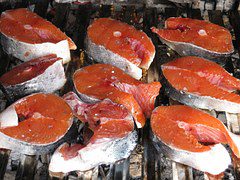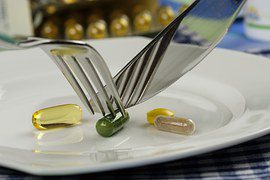I hated seafood when I was a kid. However, as I’ve gotten older, I have grown to become a serious fan of fish and so should you.
I am always telling folks not to sleep on this highly nutritious food that provides various health benefits. It is low in saturated fat and high in protein, vitamins, and minerals.
If you’re looking for an authority’s opinion, the American Heart Association recommends eating at least two servings of fish per week to reduce the risk of heart disease.
In this post, I provide five simple ways to introduce more fish into your diet.

Begin by choosing the right types of fish:
Not all fish are created equal when it comes to health benefits. Some fish, like salmon, tuna, and sardines, are rich in omega-3 fatty acids, which are essential for heart health, brain function, and eye health.
Other types of fish, like tilapia and catfish, are low in omega-3s and may contain higher levels of harmful pollutants.
When choosing fish, opt for those that are high in omega-3s and low in mercury and other toxins.
Experiment with different cooking methods:
Fish can be cooked in a variety of ways, including grilling, baking, broiling, and frying. Experiment with different cooking methods to find your favorite way to prepare fish.
Grilling and baking are healthy options that preserve the nutritional value of fish without adding extra calories from oil or breading.
Frying, on the other hand, can add unnecessary calories and fat. Air fryers have become popular in recent years, and often considered a good option over deep frying; plus, far fewer calories.
If you do choose to fry fish, use healthy oils like olive or avocado oil and avoid breaded or battered fish.
Incorporate fish into your favorite recipes:
Adding fish to your favorite recipes is a common way to incorporate more of it into your diet.
For example, try adding baked salmon to your salad or sandwich, or adding shrimp to your pasta dish.
 Tuna and salmon are also great options for making healthy and delicious fish cakes or burgers. Fish can also be used in tacos, stir-fries, and even pizza!
Tuna and salmon are also great options for making healthy and delicious fish cakes or burgers. Fish can also be used in tacos, stir-fries, and even pizza!
Try new types of seafood:
While salmon and tuna are popular options, there are many other types of seafood to choose from.
Shrimp, scallops, mussels, and clams are all delicious and nutritious seafood options. Lobster and crab are also great choices for special occasions.
Don’t be afraid to try new types of seafood and experiment with different flavors and textures.
Eat fish at least twice a week:
To get the maximum health benefits from fish, it is recommended to eat it at least twice a week. This will help ensure that you are getting enough omega-3s and other nutrients that fish provide. Make fish a regular part of your meal plan by planning ahead and buying fresh or frozen fish at the grocery store. Begin by reserving Friday as the designated day for fish.
Many people don’t know that fish is a highly nutritious food that contains a variety of essential nutrients beyond protein.
Consider these key nutrients found in fish:

Omega-3 fatty acids:
Fish is an excellent source of omega-3 fatty acids, which are essential fats that our body cannot produce on its own. Omega-3s are important for heart health, brain function, and eye health.
Vitamin D:
Fish is one of the few dietary sources of vitamin D, a nutrient that is essential for bone health and immune function. It also plays a role in regulating mood and preventing chronic diseases.
Vitamin B12:
Fish is a rich source of vitamin B12, a nutrient that is important for nerve function and red blood cell formation, and found mostly in animal-based foods. Fish is a particularly good source for those following a plant-based diet.
Selenium:
Fish is a good source of selenium, a mineral that is important for immune function and thyroid health. It also has antioxidant properties and may help reduce the risk of certain cancers.
Iodine:
Fish is a natural source of iodine, a mineral that is essential for thyroid function. Iodine deficiency is a common problem worldwide, and fish can help ensure adequate intake of this important nutrient.
Potassium:
Some types of fish, such as salmon and tuna, are also good sources of potassium, a mineral that is important for heart health and blood pressure regulation.
In addition to these key nutrients, fish also contains small amounts of other vitamins and minerals, including iron, zinc, and magnesium. Eating fish regularly can help ensure adequate intake of these essential nutrients and promote overall health and well-being.
I explored a pescatarian lifestyle more than a decade ago, so I know first hand that fish is a very nutritious and tasty food that provides numerous health benefits.
By choosing the right types of fish, experimenting with different cooking methods, incorporating fish into your favorite recipes, trying new types of seafood, and eating fish at least twice a week, you can easily add more fish into your diet.
Try this easy to follow recipe below:
Baked Salmon with Lemon and Garlic
Ingredients:
4 salmon filets, about 6 ounces each
- 2 cloves garlic, minced
- 2 tbsp. fresh lemon juice
- 2 tbsp. olive oil
- Salt and pepper to taste
- Lemon slices and fresh parsley for garnish
Instructions:
Preheat your oven to 400°F.
Season the salmon filets with salt and pepper, then place them in a baking dish.
In a small bowl, whisk together the minced garlic, lemon juice, and olive oil.
Pour the garlic and lemon mixture over the salmon filets, making sure they are evenly coated.
Bake the salmon in the preheated oven for about 15-20 minutes, or until the salmon is cooked through and flakes easily with a fork.
Once cooked, remove the salmon from the oven and let it rest for a few minutes.
Garnish the salmon with lemon slices and fresh parsley before serving.
This recipe is fairly simple and an easy way to incorporate healthy salmon into your diet. Salmon is a rich source of omega-3 fatty acids, which are important for heart health and brain function. The addition of garlic and lemon provides a burst of flavor without adding extra calories, making this dish both healthy and delicious.
Enjoy!
